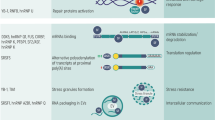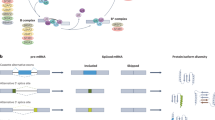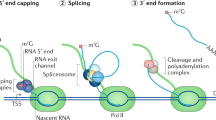Abstract
In this study, we show that interfering with the splicing machinery results in activation of the tumour-suppressor p53. The spliceosome was targeted by small interfering RNA-mediated knockdown of proteins associated with different small nuclear ribonucleoprotein complexes and by using the small-molecule splicing modulator TG003. These interventions cause: the accumulation of p53, an increase in p53 transcriptional activity and can result in p53-dependent G1 cell cycle arrest. Mdm2 and MdmX are two key repressors of p53. We show that a decrease in MdmX protein level contributes to p53 activation in response to targeting the spliceosome. Interfering with the spliceosome also causes an increase in the rate of degradation of Mdm2. Alterations in splicing are linked with tumour development. There are frequently global changes in splicing in cancer. Our study suggests that p53 activation could participate in protection against potential tumour-promoting defects in the spliceosome. A number of known p53-activating agents affect the splicing machinery and this could contribute to their ability to upregulate p53. Preclinical studies indicate that tumours can be more sensitive than normal cells to small-molecule spliceosome inhibitors. Activation of p53 could influence the selective anti-tumour activity of this therapeutic approach.
This is a preview of subscription content, access via your institution
Access options
Subscribe to this journal
Receive 50 print issues and online access
$259.00 per year
only $5.18 per issue
Buy this article
- Purchase on Springer Link
- Instant access to full article PDF
Prices may be subject to local taxes which are calculated during checkout









Similar content being viewed by others
References
Lane DP, Cheok CF, Lain S . p53-based cancer therapy. Cold Spring Harb Perspect Biol 2010; 2: a001222.
Cheok CF, Verma CS, Baselga J, Lane DP . Translating p53 into the clinic. Nat Rev Clin Oncol. 2011; 8: 25–37.
Brooks CL, Gu W . p53 regulation by ubiquitin. FEBS Lett 2011; 585: 2803–2809.
Hock A, Vousden KH . Regulation of the p53 pathway by ubiquitin and related proteins. Int J Biochem Cell Biol 2010; 42: 1618–1621.
Lenos K, Jochemsen AG . Functions of MDMX in the modulation of the p53-response. J Biomed Biotechnol 2011; 2011: 876173.
Wade M, Wang YV, Wahl GM . The p53 orchestra: Mdm2 and Mdmx set the tone. Trends Cell Biol 2010; 20: 299–309.
Marine JC, Dyer MA, Jochemsen AG . MDMX: from bench to bedside. J Cell Sci 2007; 120: 371–378.
Stommel JM, Wahl GM . Accelerated MDM2 auto-degradation induced by DNA-damage kinases is required for p53 activation. EMBO J 2004; 23: 1547–1556.
Kawai H, Wiederschain D, Kitao H, Stuart J, Tsai KK, Yuan ZM . DNA damage-induced MDMX degradation is mediated by MDM2. J Biol Chem 2003; 278: 45946–45953.
Wang YV, Wade M, Wong E, Li YC, Rodewald LW, Wahl GM . Quantitative analyses reveal the importance of regulated Hdmx degradation for p53 activation. Proc Natl Acad Sci USA 2007; 104: 12365–12370.
Will CL, Luhrmann R . Spliceosome Structure and Function. Cold Spring Harb Perspect Biol 2011; 3: 1–23.
Ritchie DB, Schellenberg MJ, MacMillan AM . Spliceosome structure: piece by piece. Biochim Biophys Acta 2009; 1789: 624–633.
Newman AJ, Nagai K . Structural studies of the spliceosome: blind men and an elephant. Curr Opin Struct Biol 2010; 20: 82–89.
Valadkhan S, Jaladat Y . The spliceosomal proteome: at the heart of the largest cellular ribonucleoprotein machine. Proteomics 2010; 10: 4128–4141.
Pan Q, Shai O, Lee LJ, Frey BJ, Blencowe BJ . Deep surveying of alternative splicing complexity in the human transcriptome by high-throughput sequencing. Nat Genet 2008; 40: 1413–1415.
Wang ET, Sandberg R, Luo S, Khrebtukova I, Zhang L, Mayr C et al. Alternative isoform regulation in human tissue transcriptomes. Nature 2008; 456: 470–476.
Black DL . Protein diversity from alternative splicing: a challenge for bioinformatics and post-genome biology. Cell 2000; 103: 367–370.
Blencowe BJ . Alternative splicing: new insights from global analyses. Cell 2006; 126: 37–47.
Smith CW, Valcarcel J . Alternative pre-mRNA splicing: the logic of combinatorial control. Trends Biochem Sci 2000; 25: 381–388.
David CJ, Manley JL . Alternative pre-mRNA splicing regulation in cancer: pathways and programs unhinged. Genes Dev 2010; 24: 2343–2364.
Ward AJ, Cooper TA . The pathobiology of splicing. J Pathol 2010; 220: 152–163.
Fackenthal JD, Godley LA . Aberrant RNA splicing and its functional consequences in cancer cells. Dis Model Mech 2008; 1: 37–42.
Ritchie W, Granjeaud S, Puthier D, Gautheret D . Entropy measures quantify global splicing disorders in cancer. PLoS Comput Biol 2008; 4: e1000011.
Reyal F, van Vliet MH, Armstrong NJ, Horlings HM, de Visser KE, Kok M et al. A comprehensive analysis of prognostic signatures reveals the high predictive capacity of the proliferation, immune response and RNA splicing modules in breast cancer. Breast Cancer Res 2008; 10: R93.
Grosso AR, Martins S, Carmo-Fonseca M . The emerging role of splicing factors in cancer. EMBO Rep 2008; 9: 1087–1093.
Andre F, Michiels S, Dessen P, Scott V, Suciu V, Uzan C et al. Exonic expression profiling of breast cancer and benign lesions: a retrospective analysis. Lancet Oncol 2009; 10: 381–390.
Kotake Y, Sagane K, Owa T, Mimori-Kiyosue Y, Shimizu H, Uesugi M et al. Splicing factor SF3b as a target of the antitumor natural product pladienolide. Nat Chem Biol 2007; 3: 570–575.
Kaida D, Motoyoshi H, Tashiro E, Nojima T, Hagiwara M, Ishigami K et al. Spliceostatin A targets SF3b and inhibits both splicing and nuclear retention of pre-mRNA. Nat Chem Biol 2007; 3: 576–583.
Grainger RJ, Beggs JD . Prp8 protein: at the heart of the spliceosome. RNA 2005; 11: 533–557.
Wilkinson CR, Dittmar GA, Ohi MD, Uetz P, Jones N, Finley D . Ubiquitin-like protein Hub1 is required for pre-mRNA splicing and localization of an essential splicing factor in fission yeast. Curr Biol 2004; 14: 2283–2288.
Alexander R, Beggs JD . Cross-talk in transcription, splicing and chromatin: who makes the first call? Biochem Soc Trans 2010; 38: 1251–1256.
Xiao SH, Manley JL . Phosphorylation of the ASF/SF2 RS domain affects both protein–protein and protein–RNA interactions and is necessary for splicing. Genes Dev 1997; 11: 334–344.
Cao W, Garcia-Blanco MA . A serine/arginine-rich domain in the human U1 70k protein is necessary and sufficient for ASF/SF2 binding. J Biol Chem 1998; 273: 20629–20635.
Hernandez H, Makarova OV, Makarov EM, Morgner N, Muto Y, Krummel DP et al. Isoforms of U1-70k control subunit dynamics in the human spliceosomal U1 snRNP. PLoS One 2009; 4: e7202.
Golas MM, Sander B, Will CL, Luhrmann R, Stark H . Molecular architecture of the multiprotein splicing factor SF3b. Science 2003; 300: 980–984.
Cass DM, Berglund JA . The SF3b155 N-terminal domain is a scaffold important for splicing. Biochemistry 2006; 45: 10092–10101.
Makarova OV, Makarov EM, Luhrmann R . The 65 and 110 kDa SR-related proteins of the U4/U6.U5 tri-snRNP are essential for the assembly of mature spliceosomes. EMBO J 2001; 20: 2553–2563.
Schaffert N, Hossbach M, Heintzmann R, Achsel T, Luhrmann R . RNAi knockdown of hPrp31 leads to an accumulation of U4/U6 di-snRNPs in Cajal bodies. EMBO J 2004; 23: 3000–3009.
Corrionero A, Minana B, Valcarcel J . Reduced fidelity of branch point recognition and alternative splicing induced by the anti-tumor drug spliceostatin A. Genes Dev 2011; 25: 445–459.
Muraki M, Ohkawara B, Hosoya T, Onogi H, Koizumi J, Koizumi T et al. Manipulation of alternative splicing by a newly developed inhibitor of Clks. J Biol Chem 2004; 279: 24246–24254.
Ghosh G, Adams JA . Phosphorylation mechanism and structure of serine-arginine protein kinases. FEBS J 2011; 278: 587–597.
Bartel F, Harris LC, Wurl P, Taubert H . MDM2 and its splice variant messenger RNAs: expression in tumors and down-regulation using antisense oligonucleotides. Mol Cancer Res 2004; 2: 29–35.
Bonner WM, Redon CE, Dickey JS, Nakamura AJ, Sedelnikova OA, Solier S et al. GammaH2AX and cancer. Nat Rev Cancer 2008; 8: 957–967.
Ljungman M . The transcription stress response. Cell Cycle 2007; 6: 2252–2257.
Svejstrup JQ . Contending with transcriptional arrest during RNAPII transcript elongation. Trends Biochem Sci 2007; 32: 165–171.
Brody Y, Neufeld N, Bieberstein N, Causse SZ, Bohnlein EM, Neugebauer KM et al. The in vivo kinetics of RNA polymerase II elongation during co-transcriptional splicing. PLoS Biol 2011; 9: e1000573.
Singh J, Padgett RA . Rates of in situ transcription and splicing in large human genes. Nat Struct Mol Biol 2009; 16: 1128–1133.
Kim MY, Hur J, Jeong S . Emerging roles of RNA and RNA-binding protein network in cancer cells. BMB Rep 2009; 42: 125–130.
Venables JP, Klinck R, Koh C, Gervais-Bird J, Bramard A, Inkel L et al. Cancer-associated regulation of alternative splicing. Nat Struct Mol Biol 2009; 16: 670–676.
Kim E, Goren A, Ast G . Insights into the connection between cancer and alternative splicing. Trends Genet 2008; 24: 7–10.
Utans U, Behrens SE, Luhrmann R, Kole R, Kramer A . A splicing factor that is inactivated during in vivo heat shock is functionally equivalent to the [U4/U6.U5] triple snRNP-specific proteins. Genes Dev 1992; 6: 631–641.
Disher K, Skandalis A . Evidence of the modulation of mRNA splicing fidelity in humans by oxidative stress and p53. Genome 2007; 50: 946–953.
Zhao X, Yu YT . Incorporation of 5-fluorouracil into U2 snRNA blocks pseudouridylation and pre-mRNA splicing in vivo. Nucleic Acids Res 2007; 35: 550–558.
Lain S, Midgley C, Sparks A, Lane EB, Lane DP . An inhibitor of nuclear export activates the p53 response and induces the localization of HDM2 and p53 to U1A-positive nuclear bodies associated with the PODs. Exp Cell Res 1999; 248: 457–472.
Sleeman J . A regulatory role for CRM1 in the multi-directional trafficking of splicing snRNPs in the mammalian nucleus. J Cell Sci 2007; 120: 1540–1550.
Busa R, Sette C . An emerging role for nuclear RNA-mediated responses to genotoxic stress. RNA Biol 2010; 7: 390–396.
Matsuoka S, Ballif BA, Smogorzewska A, McDonald 3rd ER, Hurov KE, Luo J et al. ATM and ATR substrate analysis reveals extensive protein networks responsive to DNA damage. Science 2007; 316: 1160–1166.
Katzenberger RJ, Marengo MS, Wassarman DA . ATM and ATR pathways signal alternative splicing of Drosophila TAF1 pre-mRNA in response to DNA damage. Mol Cell Biol 2006; 26: 9256–9267.
Munoz MJ, Perez Santangelo MS, Paronetto MP, de la Mata M, Pelisch F, Boireau S et al. DNA damage regulates alternative splicing through inhibition of RNA polymerase II elongation. Cell 2009; 137: 708–720.
Bourdon JC, Fernandes K, Murray-Zmijewski F, Liu G, Diot A, Xirodimas DP et al. p53 isoforms can regulate p53 transcriptional activity. Genes Dev 2005; 19: 2122–2137.
Marcel V, Perrier S, Aoubala M, Ageorges S, Groves MJ, Diot A et al. Delta160p53 is a novel N-terminal p53 isoform encoded by Delta133p53 transcript. FEBS Lett 2010; 584: 4463–4468.
Chandler DS, Singh RK, Caldwell LC, Bitler JL, Lozano G . Genotoxic stress induces coordinately regulated alternative splicing of the p53 modulators MDM2 and MDM4. Cancer Res 2006; 66: 9502–9508.
Egecioglu DE, Chanfreau G . Proofreading and spellchecking: a two-tier strategy for pre-mRNA splicing quality control. RNA 2011; 17: 383–389.
Dayal S, Sparks A, Jacob J, Allende-Vega N, Lane DP, Saville MK . Suppression of the deubiquitinating enzyme USP5 causes the accumulation of unanchored polyubiquitin and the activation of p53. J Biol Chem 2009; 284: 5030–5041.
Allende-Vega N, Sparks A, Lane DP, Saville MK . MdmX is a substrate for the deubiquitinating enzyme USP2a. Oncogene 2010; 29: 432–441.
Stevenson LF, Sparks A, Allende-Vega N, Xirodimas DP, Lane DP, Saville MK . The deubiquitinating enzyme USP2a regulates the p53 pathway by targeting Mdm2. EMBO J 2007; 26: 976–986.
Giglio S, Mancini F, Gentiletti F, Sparaco G, Felicioni L, Barassi F et al. Identification of an Aberrantly Spliced Form of HDMX in Human Tumors: A New Mechanism for HDM2 Stabilization. Cancer Res 2005; 65: 9687–9694.
Acknowledgements
This work was funded by Cancer Research UK.
Author information
Authors and Affiliations
Corresponding author
Ethics declarations
Competing interests
The authors declare no conflict of interest.
Additional information
Supplementary Information accompanies the paper on the Oncogene website
Supplementary information
Rights and permissions
About this article
Cite this article
Allende-Vega, N., Dayal, S., Agarwala, U. et al. p53 is activated in response to disruption of the pre-mRNA splicing machinery. Oncogene 32, 1–14 (2013). https://doi.org/10.1038/onc.2012.38
Received:
Revised:
Accepted:
Published:
Issue Date:
DOI: https://doi.org/10.1038/onc.2012.38
Keywords
This article is cited by
-
USP39 attenuates the antitumor activity of cisplatin on colon cancer cells dependent on p53
Cell Biology and Toxicology (2023)
-
USP39 promotes malignant proliferation and angiogenesis of renal cell carcinoma by inhibiting VEGF-A165b alternative splicing via regulating SRSF1 and SRPK1
Cancer Cell International (2021)
-
Apoptosis induction and cell cycle arrest of pladienolide B in erythroleukemia cell lines
Investigational New Drugs (2020)
-
DDX5 plays essential transcriptional and post-transcriptional roles in the maintenance and function of spermatogonia
Nature Communications (2019)
-
The PDK1 Inhibitor Dichloroacetate Controls Cholesterol Homeostasis Through the ERK5/MEF2 Pathway
Scientific Reports (2017)



